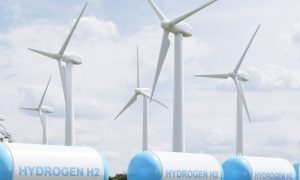Green hydrogen surge: India targets ₹10.6 lakh crore investment to fuel 135 GW clean energy

India’s National Green Hydrogen Mission aims to produce 5 million tonnes of green hydrogen annually by 2030, attracting ₹10.6 lakh crore ($129 billion) in investment. The initiative will add 135 GW of renewable energy, mainly wind and solar, helping decarbonize industries and reduce fossil fuel dependence. Key states like Gujarat and Tamil Nadu will lead this transition.
New Delhi: India’s National Green Hydrogen Mission is set to attract an investment of ₹10.6 lakh crore ($129 billion) by 2030, as the country gears up to produce 5 million tonnes of green hydrogenannually. This initiative will add a significant 135 GW of renewable energy capacity, with a focus on wind and solar power, to support hydrogen production. The mission is central to India’s broader strategy to decarbonize its energy sector and reduce its dependence on fossil fuels.
According to a report by the Council on Energy, Environment, and Water (CEEW), the production of green hydrogen will require 84 GW of wind energy and 51 GW of solar energy. The states of Gujarat and Tamil Nadu will play a critical role in this energy transition, contributing 43% and 24%, respectively, of the total renewable energy required. Other key states like Maharashtra, Andhra Pradesh, and Rajasthan will also contribute significantly to the mission, helping India meet its goal of reducing carbon emissions while addressing energy security.
Investments powering India’s green hydrogen ambitions
The green hydrogen initiative will demand an enormous financial commitment of ₹10.6 lakh crore by 2030, aimed at building renewable energy infrastructure and electrolyser capacity. Electrolysers, which split water into hydrogen and oxygen, will play a key role in this mission,
and India will need 74 GW of electrolyser capacity to meet its hydrogen production targets. This will allow India to decarbonize major industries like fertilisers, refineries, and methanol production, sectors that rely heavily on conventional energy sources.
The report highlights that this transition will also impact India’s power demand significantly. The production of green hydrogen is expected to increase the country’s peak electricity demand by 67 GW by 2030, pushing total demand to 409 GW. This increase is driven by the 310 billion units (BU) of electricity required annually for hydrogen production. Gujarat, Maharashtra, Tamil Nadu, Andhra Pradesh, and Karnataka are expected to be the major hubs for this energy-intensive shift.
One of the key goals of the Green Hydrogen Mission is to reduce India’s reliance on conventional fossil fuels and cut down on imports. As the world shifts towards cleaner energy sources, India is positioning itself as a leader in renewable energy, with the potential to become a major exporter of green hydrogen to global markets, including Japan, South
Korea, and the European Union.
The integration of green hydrogen into India’s energy mix will also contribute to the country’s broader goal of achieving net-zero emissions by 2070. The government’s commitment to renewable energy is further reflected in the projected increase in renewable energy’s share of the total generation mix, rising from 11% in 2022 to 40% by 2030.
Grid flexibility and cost implication
As green hydrogen production ramps up, India’s power grid will need to become more flexible to accommodate the fluctuating supply of solar and wind energy. Electrolysers, with their ability to adjust output quickly, will be crucial in maintaining grid stability. The report notes that the ramping capabilities of electrolysers could reduce the need for 6 GW
of battery storage systems, helping to lower system costs.
Moreover, the efficient integration of renewable energy for hydrogen production through India’s inter-state transmission system (ISTS) will save an estimated ₹20,500 crore ($2.5 billion) by optimally using surplus energy in some states. This approach will prevent the need for additional capacity in non-windy regions like Uttar Pradesh, Punjab, and Haryana.
India’s power system will see growing demands for grid flexibility as renewable energy’s share increases. To balance the grid during non-solar hours, coal and hydroelectric plants will continue to play an important role, especially on days when maximum renewable energy generation occurs.
Falling costs and long-term gains
The report also projects that the average cost of power generation in India will decrease by 2% due to the growing contribution of renewable energy. The average cost is expected to drop from ₹3.83 per kilowatthour (kWh) to ₹3.76 per kWh, resulting in an annual saving of ₹18,800 crore ($2.3 billion). This will make green hydrogen even more
competitive and contribute to the affordability of clean energy in India.
The road ahead
India’s green hydrogen mission is a crucial part of the country’s transition to a low-carbon economy. The additional 135 GW of renewable energy, coupled with the production of 5 million tonnes of green hydrogen annually, will help India decarbonize key sectors and reduce its carbon footprint. Moreover, as global demand for green hydrogen grows,
India’s investment in this sector could position the country as a major player in the international energy market.
With substantial investments and the expansion of renewable energy, India is taking significant strides toward energy security and sustainability. The National Green Hydrogen Mission is not just a step toward cleaner energy but also a pathway to a greener, more resilient future for the country’s power system. As the world moves toward reducing emissions, India’s focus on green hydrogen will play a pivotal
role in shaping its energy landscape for decades to come.

















